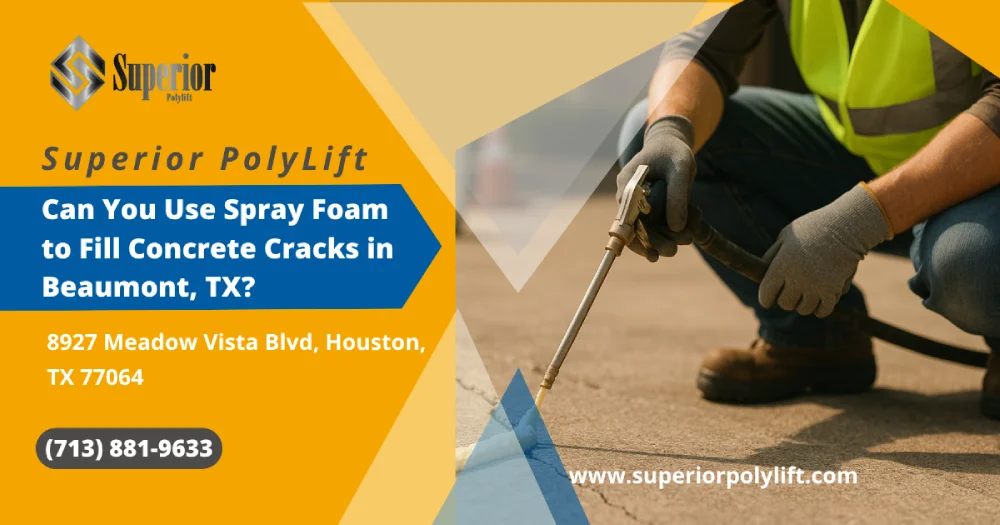
Spray foam often looks like an easy cure-all for cracked concrete—aim, fill, and forget. Reality is more complex. While off-the-shelf foam can seal hairline gaps, industrial concrete in Beaumont, TX usually needs higher-density polyurethane, professional foam injection, or engineered grouting solutions to stay safe and structurally sound. Below, we unpack every option—from fast polyurethane foam injection and concrete leveling in Beaumont to heavy-duty compaction grouting—so your next project rests on solid ground.
Before you buy a can, it helps to understand what “spray foam” really means in geotechnical and concrete-leveling work in Beaumont.
General spray foam is a two-component polyurethane that mixes at the nozzle, then expands. Open-cell versions stay flexible; closed-cell foam delivers higher density and minimal water absorption—critical traits when foam is injected beneath a concrete slab exposed to coastal moisture.
Because the adhesive bond is mostly mechanical—not chemical—vibration from forklifts or semi-trailers can break it loose. That’s why many projects in Beaumont eventually upgrade to polyurethane foam concrete lifting or compaction grouting for durability.
Pros
Cons
Beaumont’s high groundwater puts constant hydrostatic pressure on repairs. If foam concrete lifting material is not hydrophobic, water infiltration can create new voids beneath the concrete slab. Polyurethane grout formulated for marine exposure performs far better than generic foam.
Polyurethane foam lifting—sometimes branded as PolyLift or polyurethane foam injection—isn’t the same material you find at a hardware store. Think of it as concrete engineering, not crack caulking.
| Property | Polyurethane Concrete Lifting Foam | Generic Spray Foam | Traditional Mudjacking Grout |
| Density | 2–4 lb/ft³ (lightweight yet strong) | 1–2 lb/ft³ | 120 lb/ft³ |
| Compressive Strength | 100–150 psi | 30–50 psi | 2,000–3,000 psi |
| Cure Time to Traffic | 15–30 min (rapid cure) | 1–2 hr | 24–48 hr |
| Typical Drill Hole | 5/8 in. | ¼ in. straw | 1–2 in. |
| Environmental Upside | Hydro-insensitive, inert | Possible off-gassing | Adds dead load to soft soils |
Some Beaumont sites need more than foam. Compaction grouting, cellular concrete, and polyurethane grouting in Beaumont, offered by Superior Grouting Services, deliver added bearing capacity for equipment foundations and rail beds.
Discover how our grouting solutions can support your next project by reducing downtime and keeping slab integrity and reliability in check.
| Factor | Spray Foam | Polyurethane Concrete Lifting | Compaction Grouting |
| Average Cost in Beaumont | Lowest | Mid | Highest |
| Cure Time | 1–2 hr | 15–30 min | 4–24 hr |
| Weight Added | Negligible | Negligible | Moderate |
| Best For | Cosmetic cracks | Concrete leveling services & rapid return to service | Deep soil densification |
Because polyurethane adds almost no weight, it’s often the most cost-effective life-cycle choice—even if the initial ticket price is higher than a can of foam.
Choosing between foam, grout, or cellular concrete isn’t guesswork; it’s geotechnical science. An experienced grouting contractor inspects soil borings, moisture readings, and load charts to recommend the safest, most economical plan. Superior PolyLift™ and our allied Superior Grouting team offer repair solutions and personalized service, backed by nationally backed warranties and local crews who know Beaumont’s unique soil profile.
Look for:
Spray foam can plug small cracks, but polyurethane foam injection, concrete leveling, and geotechnical grouting deliver the muscle Beaumont’s heavy-duty slabs demand. When equipment uptime, safety, and integrity and reliability matter, partner with Superior PolyLift™. Our grouting solutions can support your next Southeast Texas project—from Port of Beaumont docks to high-cycle logistics terminals—without the headaches of full replacement.

Explore how our expertise can benefit your project. Reach out to our team for a consultation and discover the best solutions for your needs.
Copyright © All rights reserved. 2024 • Terms of Use and Privacy Policy • Internet Marketing by Authority Solutions®